India
Political Turmoil: Parliament Adjourned Amid Opposition Protests Over Amit Shah’s Remarks on Ambedkar

Contents
Introduction to the Incident
The recent political landscape has been notably tumultuous, marked by significant unrest within the Indian Parliament. Both houses convened but were quickly adjourned due to intense and sustained protests from opposition leaders. The catalyst for these disruptions was an incendiary remark made by Union Home Minister Amit Shah concerning Dr. B.R. Ambedkar, an iconic figure in Indian history and the architect of the Indian Constitution. This comment ignited outrage among various political factions, leading to a chaotic atmosphere that made it impossible for parliamentary proceedings to continue.
Amit Shah’s remarks, perceived by many as disrespectful to Ambedkar’s legacy, formulated the epicenter of the protests. Opposition parties, including several regional outfits, expressed their vehement disapproval, arguing that such comments undermine the values for which Ambedkar fought, including social justice and equality. The historical significance of Ambedkar’s contributions to the civil rights movement in India makes discussions surrounding him particularly sensitive. Therefore, any perceived slight can provoke strong reactions, as demonstrated in this instance.
The uproar extended beyond the walls of Parliament, with various social organizations and activist groups also joining the fray, amplifying the discontent through public demonstrations and rallies. As the coalitions in Parliament clashed over these comments, it underscored the fractious state of Indian politics, where ideological divides often reignite deep-seated tensions. The interruption of parliamentary proceedings not only highlights the current political discord but also reflects broader societal issues regarding caste and representation, as Ambedkar remains a pivotal figure in advocating for marginalized communities.
This incident sets a poignant backdrop for examining the intricacies of modern Indian politics, especially concerning the navigation of sensitive historical narratives and their implications in present-day governance. The initial reactions following Amit Shah’s comments illuminate the political dynamics at play and the ongoing struggle for representation and recognition within the societal framework.
Background on Dr. B.R. Ambedkar
Dr. Bhimrao Ramji Ambedkar, widely known as B.R. Ambedkar, was a prominent Indian jurist, economist, and social reformer who played a pivotal role in the transformation of Indian society through his efforts to promote social justice and equality. Born on April 14, 1891, in Mhow, Madhya Pradesh, Ambedkar faced considerable discrimination and prejudice due to his caste. Despite these challenges, he excelled academically and earned degrees from prestigious institutions, including Columbia University and the London School of Economics.
As the principal architect of the Indian Constitution, Ambedkar’s contributions were vital in laying the foundation for a democratic nation committed to social justice. His advocacy for the rights of the marginalized and the abolition of untouchability significantly influenced the constitutional provisions that protect the rights of all citizens, particularly those from underprivileged communities. Through his vision, the Constitution emerged as a document that enshrined principles of liberty, equality, and fraternity, making it a cornerstone for India’s democracy.
Beyond his constitutional contributions, Dr. Ambedkar’s efforts as a social reformer were marked by his relentless campaign against caste discrimination. He championed women’s rights, advocated for labor rights, and emphasized the necessity of education for empowerment. His significant writings and speeches continue to resonate in contemporary political discourse, highlighting issues of caste-based discrimination and social justice. Ambedkar was not only a legal scholar but also a thinker who challenged the status quo, urging society to reassess deep-rooted injustices that persist today. His legacy is thus not merely historical but is also woven into the fabric of current socio-political conversations, as various movements seek to achieve the ideals for which he fought tirelessly throughout his life.
Amit Shah’s Comments: Context and Controversy
Amit Shah, the Union Home Minister of India, found himself at the center of a political firestorm following his recent comments regarding Dr. B.R. Ambedkar, the architect of the Indian Constitution and a key figure in the fight for social justice. During a public event, Shah delivered remarks that were perceived by many as diminishing Ambedkar’s immense contributions to Indian society and the rights of marginalized communities. The comments were made in the context of a discussion aimed at showcasing the government’s achievements in the areas of social welfare and economic progress.
The immediate intent behind Shah’s remarks appeared to be to position the current administration favorably in comparison to historical figures like Ambedkar. However, critics argue that his approach was not only disrespectful to Ambedkar’s legacy but also indicative of a broader trend among some ruling party members to rewrite or reinterpret history to fortify their political narratives. Ambedkar’s work advocated for the upliftment of the downtrodden and emphasized the importance of equality and justice. By seemingly trivializing his contributions, Shah’s comments sparked outrage among opposition parties and civil society, who viewed them as an affront to the principles Ambedkar stood for.
The ensuing controversy led to intense protests from opposition parties, who accused Shah of attempting to erase Ambedkar’s significance from public discourse. These developments underscore the fragility of political discourse in India, where statements made by influential leaders can ignite widespread outrage and unrest. The implications of Shah’s comments extend beyond mere political debates; they challenge the narratives surrounding social justice and the role of historical figures in contemporary politics. With such incendiary remarks, the potential for societal division increases, complicating the already complex landscape of Indian politics.
Opposition Response: Protests Explained
The remarks made by Amit Shah concerning Dr. B.R. Ambedkar sparked significant backlash among opposition parties, resulting in widespread protests that traversed both houses of Parliament. The immediate reaction from various political factions revealed a unified front driven by a strong commitment to uphold the memory and contributions of Ambedkar, a foundational figure in Indian democracy and social justice.
Protests began with members of the opposition demanding an apology from the Home Minister for what they perceived as disrespectful comments. They argued that any remarks undermining Ambedkar not only diminish his legacy but also threaten the very principles of equality and justice he championed. The opposition’s response was both vigorous and strategic; leaders from various parties rallied their members to engage in demonstrations, emphasizing collective action to amplify their voices. This mobilization extended beyond Parliament walls, engaging civil society groups and activist organizations, which echoed the call for accountability.
Also read :Political Drama: BJP Questions Timing of Adani’s US Indictment While Congress Cries Foul
During the protests, opposition parties employed various tactics to draw attention to their cause. These included walkouts, chanting slogans, and staging sit-ins, disrupting the normal proceedings of the houses. Furthermore, statements issued by party leaders highlighted their demands for a parliamentary discussion on the remarks made by Shah, pressing for a more substantial discourse that honors Ambedkar’s legacy rather than diminishing it. This was viewed as a critical moment for opposition unity, with parties across the spectrum coming together to stand against what they termed as an affront to Ambedkar’s ideals.
The intensifying protests not only disrupted legislative activities but also generated considerable media coverage, bringing public awareness to the sentiments surrounding the issue. The opposition’s efforts to mobilize support reflected a broader concern about the implications of the remarks and the potential erosion of social harmony, reinforcing their stance as defenders of democratic values when confronted with governmental challenges.
Parliamentary Procedure: The Adjournment
The process of adjournment in parliamentary proceedings serves a critical function in ensuring that legislative activities can proceed smoothly, particularly in the face of disruptions such as protests. When opposition protests arise, particularly in response to contentious remarks or actions by government officials, it is the responsibility of the parliamentary leaders to manage the situation effectively. Adjournment is typically called when the order and decorum of the assembly are significantly compromised, allowing time for tensions to ease and for discussions to potentially address the issues at hand.
In practice, the Speaker of the House or the presiding officer holds significant authority in determining whether an adjournment is warranted. When faced with unrest, it is common for the Speaker to first attempt to restore order by calling for discipline among members. If this attempt fails to quell the disturbances, the Speaker may choose to adjourn the proceedings temporarily or even summons for a more extended period. This decision may be influenced by the nature of the protests, the level of disruption, and the significance of the matters being discussed at the time.
The impact of adjournments on legislative business can be substantial. Each unplanned adjournment effectively halts the progress of bills and discussions, which can lead to delays in the legislative calendar. Additionally, it may strain the relationship between the ruling party and opposition groups, as unresolved grievances become magnified during such interruptions. Furthermore, repeated instances of adjournment may erode public confidence in the parliamentary system’s ability to address issues effectively, potentially undermining the legitimacy of the government and its processes. Thus, understanding the procedure surrounding adjournments is crucial to comprehending the broader dynamics at play during periods of political tumult.
Public and Media Reactions
The recent parliamentary turmoil triggered by Amit Shah’s remarks on B.R. Ambedkar has garnered significant attention from various societal segments, illustrating distinct perceptions and reactions. Media coverage has played a crucial role in shaping the narrative surrounding these events. Several news outlets have adopted a critical stance towards Amit Shah, emphasizing the implications of his statements on social cohesion and the legacy of Ambedkar. Major newspapers have depicted the opposition’s protests as a legitimate expression of concerns regarding historical sensitivity and social justice. By focusing on the historical context of Ambedkar’s contributions, the media has highlighted the potential ramifications of Shah’s comments on marginalized communities.
Public figures, including activists and politicians, have echoed similar sentiments. Many renowned figures have taken to social platforms to voice their discontent, calling for accountability and adherence to Ambedkar’s principles. This influx of opinions has illustrated a widespread demand for inclusivity and respect for historical figures who have championed the rights of the oppressed. Celebrities and intellectuals have utilized their platforms to either condemn or support Amit Shah’s remarks, amplifying the debate and polarizing public sentiment.
Citizens, too, have varied in their responses, with social media serving as a powerful conduit for expression. Threads and discussions on platforms like Twitter and Facebook reflect a blend of outrage, disappointment, and support. Hashtags related to the incident have surged in popularity, evidencing the public’s engagement in this political discourse. Through these exchanges, many individuals articulated their views on the perceived disrespect towards Ambedkar, while others defended Shah’s freedom of speech, demonstrating the complexity of public opinion during politically charged moments.
Overall, the interplay between media portrayals and public reactions underscores the sensitivity surrounding political discourse involving historical figures such as B.R. Ambedkar, fostering a dynamic conversation that may resonate for some time.
Historical Context: Political Protests in India
Political protests in India have long been intertwined with the nation’s struggle for social justice and historical grievances. These movements, rooted in the complex fabric of Indian society, often emerge from the marginalization of specific communities and the demand for equitable treatment. Examining these protests provides valuable insights into current events, such as the recent unrest concerning Amit Shah’s remarks on B.R. Ambedkar, a pivotal figure in advocating for the rights of marginalized groups.
Throughout India’s history, significant protests can be traced back to the colonial era, where resistance against British rule was marked by the mobilization of diverse societal segments seeking freedom. Post-independence, the focus shifted toward addressing socio-economic disparities and historical injustices. Movements like the Dalit rights movement have played a crucial role in highlighting the systemic discrimination faced by lower castes. These protests have not only sought to bring attention to social injustices but have also pushed for substantial legislative changes.
One notable instance is the anti-Reservation protests, which saw substantial student participation and sparked intense debates about affirmative action policies. While these protests highlighted the divergent viewpoints on social justice and equity, they also brought to the forefront the historical complexities of caste dynamics in India. Conversely, other movements sought to champion the narratives of Dalits and marginalized communities, drawing inspiration from leaders like Ambedkar.
As new political developments unfold, contemporary protests can be better understood through the lens of this historical context. The recent opposition protests against the remarks made by Amit Shah underline a significant continuity in Indian politics: the tension between governmental authority and the demand for social justice. These events echo past movements, reinforcing the ongoing struggle for inclusion and representation in a diverse society.
Implications for Future Political Discourse
The recent political turmoil surrounding the remarks made by Amit Shah regarding Dr. B.R. Ambedkar has reverberated across the Indian political landscape, stirring significant debate and dissent among opposition parties. This incident not only highlights the contentious nature of caste politics in contemporary India but also raises critical questions regarding social justice and the representation of marginalized communities. As political actors recalibrate their strategies in the wake of these developments, the implications for future political discourse are profound.
Firstly, this incident may lead to a heightened emphasis on caste-related issues within political dialogues. Given that Ambedkar’s legacy symbolizes empowerment and advocacy for the rights of Scheduled Castes and Scheduled Tribes, the opposition might utilize this moment to galvanize support by framing their narratives around social equity and justice. Expecting an increased focus on caste dynamics, political parties may prioritize these discussions in their manifestos, thereby influencing their engagement with voters in upcoming elections.
Furthermore, the opposition’s protests signify a shift towards a more assertive confrontational approach against the ruling party. As political actors learn from this episode, there could be a conscious effort to amplify marginalized voices within legislative processes. This strategy may manifest through increased representation and emphasis on inclusive policies aimed at socially disadvantaged groups, seeking to establish an equitable framework within the political dialogue. The need for constructive discussions around caste and representation cannot be overstated, especially in light of historical injustices that continue to exist in various forms.
Overall, the implications of this event are likely to shape party strategies and influence the tone of political discourse in India in the foreseeable future. As parties navigate this complex landscape, the focus on social justice issues will be crucial in fostering a more inclusive dialogue that genuinely addresses the aspirations of all communities, ensuring that marginalized voices are not only heard but also represented effectively within the political arena.
Summary : The Legacy of Ambedkar and Modern Politics
Dr. B.R. Ambedkar, a visionary leader and architect of the Indian Constitution, left behind an indelible legacy that continues to resonate in modern Indian politics. His advocacy for social justice, equality, and the rights of marginalized communities is particularly relevant today, as Parliament faces upheavals and protests stemming from controversial remarks made by prominent leaders. These events underscore the persistent challenges in achieving the ideals Ambedkar fiercely championed, particularly in the context of caste-based discrimination and socio-political inequality.
Ambedkar’s commitment to the upliftment of the oppressed remains a guiding light for contemporary political discourse. His philosophy emphasized not only the need for constitutional rights but also the importance of societal recognition and respect for all individuals, regardless of their caste or creed. The protests surrounding Amit Shah’s comments indicate a growing consciousness around these issues, reminiscent of Ambedkar’s own struggles against injustices. As citizens mobilize to demand accountability and respect, it becomes evident that the legacy of Ambedkar is not just historical; it is a living, breathing force that shapes modern political landscapes.
Furthermore, Dr. Ambedkar’s calls for unity among diverse groups reflect a fundamental principle that remains pertinent amidst today’s political fragmentation. The principles he espoused—democracy, liberty, and fraternity—stand as pertinent reminders of the challenges India faces in maintaining social harmony. In this light, the ongoing political events serve as a critical reflection on Ambedkar’s ideals, urging both leaders and citizens to engage earnestly with the values he fought for.
Art
Orange Day Adds a Splash of Joy at DAV Centenary Public School, Jaipur

Jaipur, July 10, 2025
The tiny tots of DAV Centenary Public School, Jaipur lit up the campus as they came dressed in cheerful shades of orange to celebrate Orange Day with great excitement and enthusiasm.
The pre-primary wing turned into a lively sea of orange—from clothes and accessories to creative decorations—all reflecting the spirit of joy, creativity, and energy that the colour symbolizes. Teachers thoughtfully planned the day to help children not just enjoy, but also learn the meaning behind the colour orange—a symbol of hope, enthusiasm, and prosperity.
The classrooms were buzzing with laughter and activity as the little learners took part in various fun-filled games, storytelling, drawing, and creative expression sessions. To boost their communication skills, each child was encouraged to bring an orange-coloured object from home and speak a few lines about it in front of their classmates. For many, it was their first public speaking moment, and they did it with adorable confidence.
Principal Mr. A.K. Sharma visited the classrooms to cheer on the children. He appreciated the thoughtful planning of the teachers and said, “Activities like these help children build confidence, express themselves freely, and connect learning with real-life experiences.”
It was a delightful sight to watch the little ones bursting with curiosity, dressed in glowing orange, exploring and expressing themselves. The day left behind not just smiles and laughter, but also a colourful memory in the hearts of the young students.
Accident
Vadodara Bridge Tragedy: Death Toll Rises to 19, Two Still Missing – Rescue Operations Continue in Mahisagar River
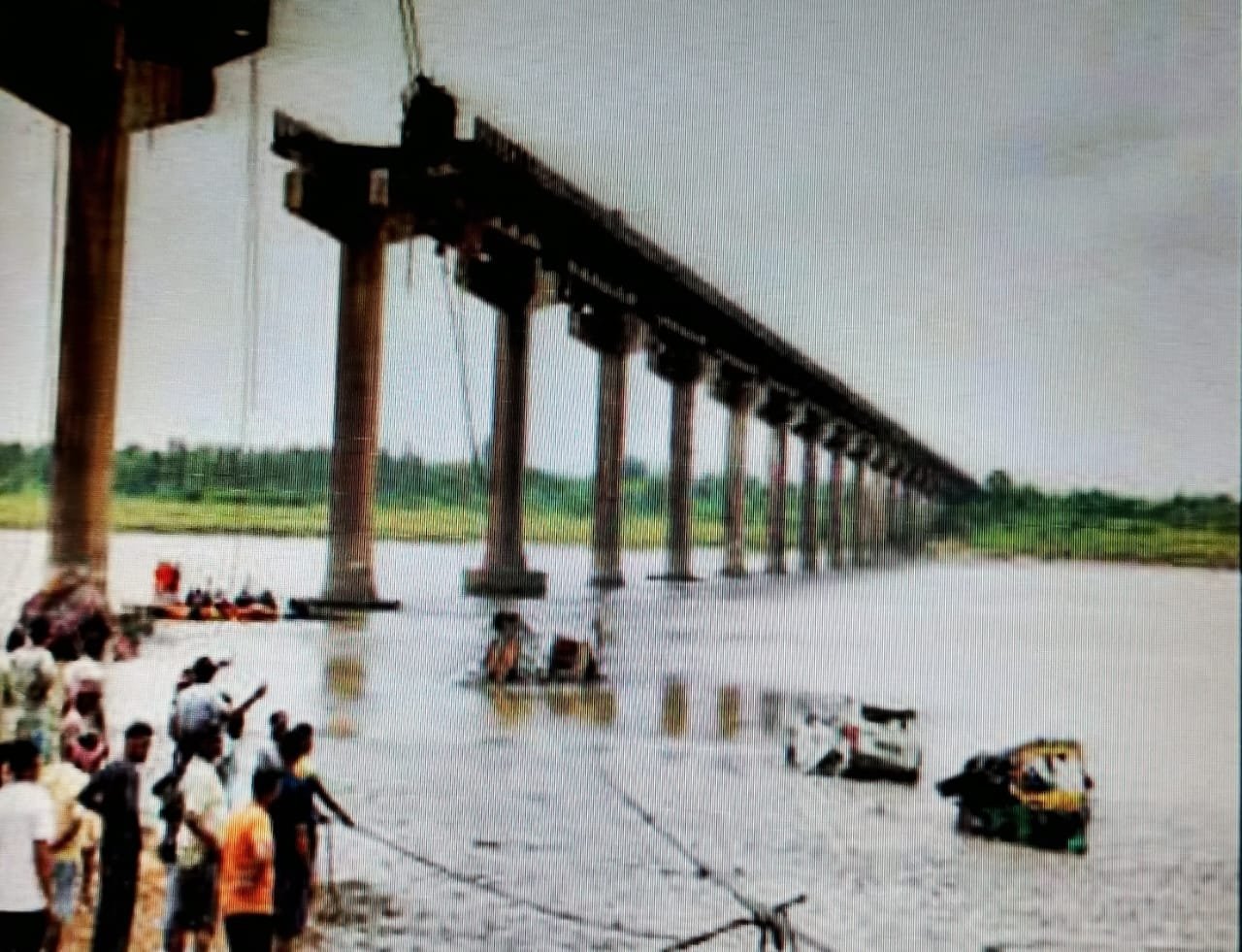
Contents
Vadodara (Gujarat), July 11, 2025
A heart-wrenching incident has shaken Gujarat as the Gambhira–Mujpur bridge over the Mahisagar River in Vadodara district collapsed unexpectedly. So far, 19 people have lost their lives, while 2 individuals remain missing. Rescue teams have been relentlessly working for the third consecutive day in the hope of saving lives and retrieving the missing.
How Did the Tragedy Happen?
The incident occurred on the morning of July 9, when several vehicles were crossing the bridge. Suddenly, a major section of the bridge collapsed into the river, dragging with it two trucks, an SUV, a pickup van, an auto-rickshaw, and two motorcycles. The bridge was nearly 40 years old, and multiple complaints had been made about its deteriorating condition.
Victims Identified, Families Devastated
So far, 18 bodies have been recovered from the debris, while one critically injured person succumbed to injuries at the hospital, taking the total death toll to 19. Among the victims were women, children, and entire families who were out on a pilgrimage for Guru Purnima.
Search Operations Still Underway
Rescue efforts by NDRF, SDRF, and fire brigade teams are still ongoing. The operation is facing major challenges due to the river’s depth, strong current, and over 10 feet of thick mud, making it difficult to access submerged vehicles. Cranes, boats, and divers are being deployed to find the two missing persons.
Government Response and Action
In the wake of the incident, the state government swiftly suspended four engineers and has ordered a detailed investigation into the bridge collapse. The government has also announced financial compensation of ₹2 lakh to the families of the deceased and ₹50,000 for the injured.
Public Outrage and Unanswered Questions
Local residents claim the bridge was already in a dangerous condition, but authorities failed to take timely action. Media reports reveal that just days before the tragedy, a journalist had posted a video highlighting the poor state of the bridge, which went ignored.
This incident has once again exposed the negligence and oversight in maintaining public infrastructure. Behind every number is a grieving family – a shattered home, a mother who lost her child, a father never to return. The need of the hour is strict accountability, immediate structural audits, and long-term corrective measures — so that such a tragedy never repeats itself.
Education
Guru Purnima Celebration at DAV CPS, Jaipur – A Heartfelt Tribute to Guiding Lights
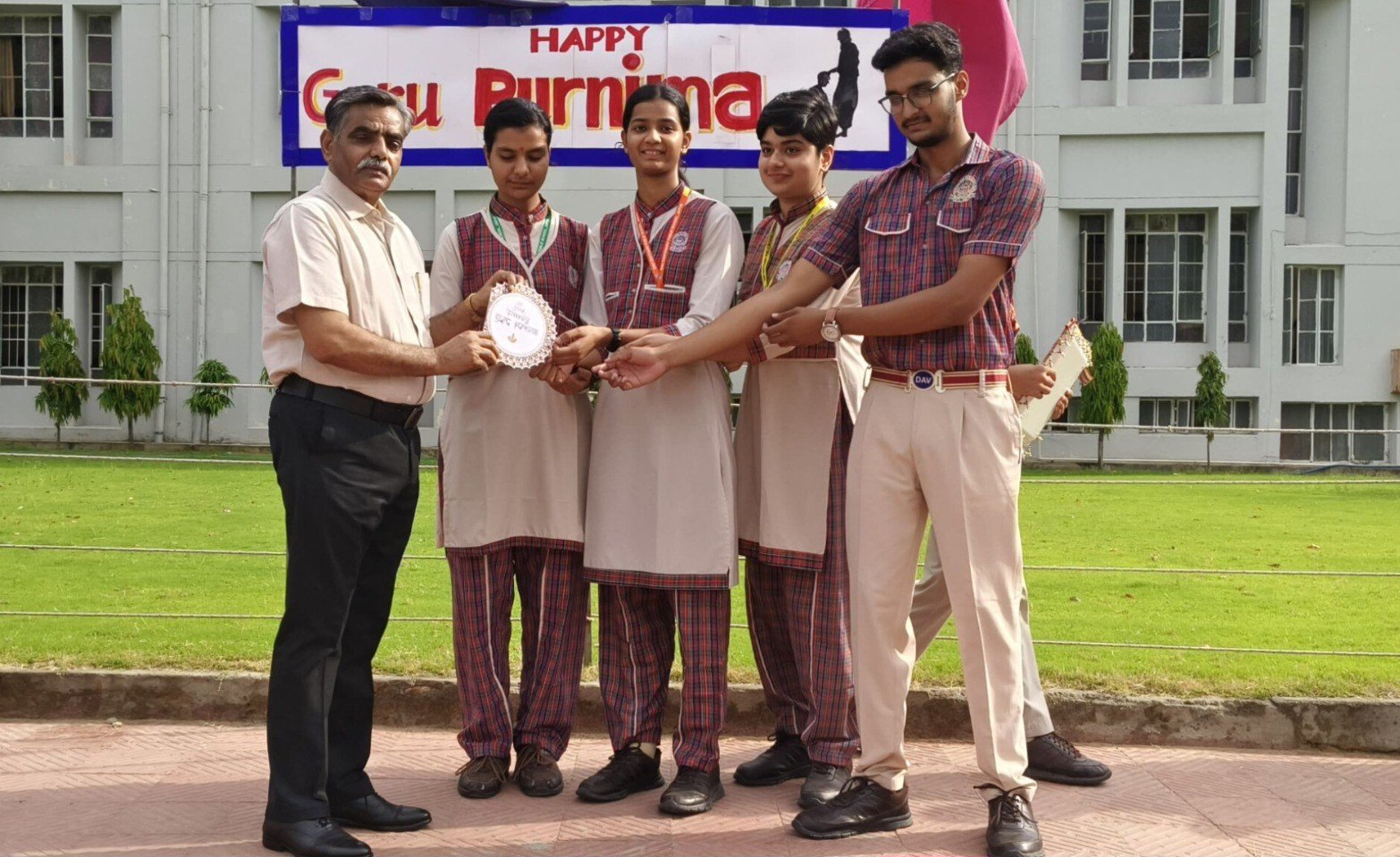
Jaipur | July 10, 2025
In an atmosphere filled with devotion, gratitude, and inspiration, DAV Centenary Public School, Vaishali Nagar, Jaipur celebrated Guru Purnima with heartfelt enthusiasm on Thursday, July 10. The event turned out to be more than just a celebration—it was a beautiful expression of love and respect for the teachers who illuminate the path of learning for their students.
The morning assembly set the tone for the day with the soothing sounds of shlokas dedicated to gurus, creating a spiritually charged environment across the campus. The essence of the celebration was beautifully captured in a speech that explained the cultural and historical roots of Guru Purnima, reminding everyone of the powerful legacy of the guru-shishya tradition.
Students poured their hearts out through soulful poems, melodious songs, and inspiring speeches, each echoing a shared sentiment—deep respect for their mentors. A mesmerizing classical dance performance, portraying devotion and reverence towards gurus, stole the spotlight and left the audience spellbound.
One of the most touching moments of the day was when the students presented a handmade gratitude card to Principal Mr. A.K. Sharma, who has been a constant source of wisdom and encouragement. In his address, Mr. Sharma reflected on the irreplaceable role of teachers in shaping young minds and urged students to stay rooted in values, discipline, and lifelong learning.
“The presence of a guru in one’s life is a blessing,” he said. “True success comes not just from knowledge, but from the humility to keep learning.”
The event concluded on a thoughtful note, leaving everyone—teachers, students, and staff—feeling more connected, more thankful, and more inspired. Guru Purnima at DAV CPS was not just an event, but an experience that reminded all of the timeless role of a teacher—not just in the classroom, but in life.
Crime
Indian Nurse to Be Hanged in 6 Days in Yemen — The Heartbreaking Story of Nimisha Priya, Who Gave Her Partner a Sedative That Turned Deadly
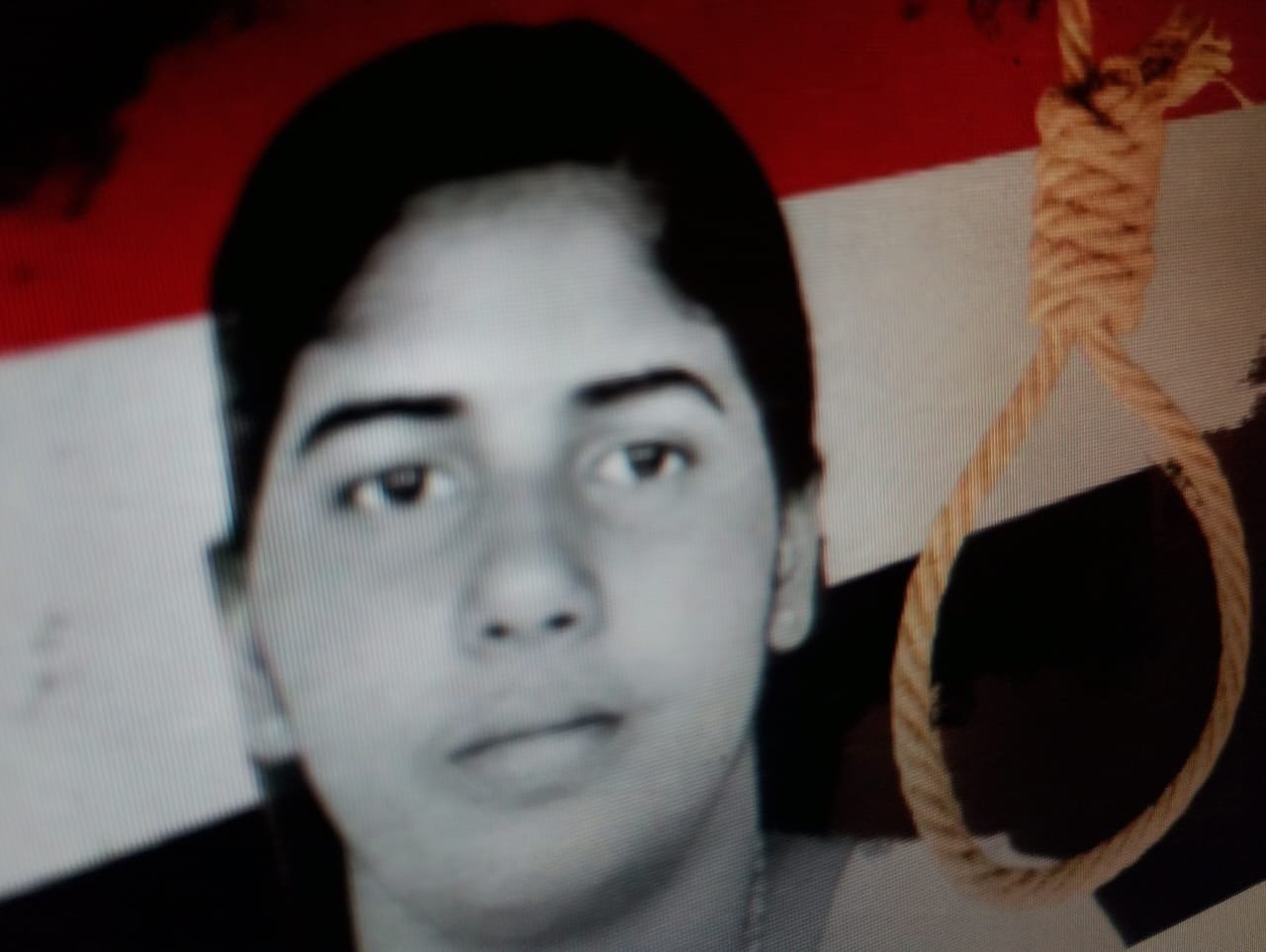
Contents
Thiruvananthapuram / Yemen | July11, 2025
Once a hopeful young nurse from Kerala, Nimisha Priya is now counting her final days in a Yemeni prison. Her crime — administering a sedative that led to the death of her Yemeni business partner, Alkhader Al-Omari. Her punishment — execution by hanging on July 13, 2025.
But behind this grim sentence lies a story much more complicated — one filled with ambition, control, fear, and a moment that changed everything.
A Nurse with Dreams, and a New Life Abroad
Nimisha Priya wasn’t a criminal when she left India. She was a caregiver — a skilled nurse with dreams of building a better life. In Yemen, she found work, opened a clinic, and partnered with Alkhader Al-Omari, a local man who helped her navigate the foreign land.
But what started as a partnership slowly turned into a prison.
Trapped in a Toxic Relationship
Reports from the time suggest that Al-Omari soon took control of more than just the clinic. He allegedly confiscated Nimisha’s passport, isolated her, and began mentally and physically abusing her. He took over her earnings and threatened her when she talked about returning home to India.
Far from family, friends, or legal protection, Nimisha felt completely trapped — her life and freedom in the hands of a man who, she believed, would never let her go.
The Night It All Changed
Then came that fateful night in 2017.
According to court documents, Nimisha gave Al-Omari a high dose of a sedative. Her stated intention was not to kill him, but to make him unconscious, retrieve her passport, and escape. But the sedative proved too strong — Al-Omari died.
Panic set in. Nimisha reportedly dismembered his body and tried to hide the evidence in a water tank. A gruesome and desperate act that, once discovered, left her no room to explain.
A Death Sentence, and a Race Against Time
The Yemeni court ruled the act pre-meditated murder and sentenced Nimisha to death by hanging.
For years, legal teams in India and Yemen pleaded for clemency. Activists pointed to the abuse she suffered, to the desperation of a woman with no escape, and to her otherwise clean record. Her mother, in tears, begged the Yemeni family for forgiveness, hoping for a “Diya” — blood money — a custom in Yemen that allows the victim’s family to pardon the accused.
But that pardon never came.
Only Six Days Left…
Today, Nimisha Priya is a prisoner not just behind bars, but in time. With just six days left, she awaits her execution. Her mother is still trying — hoping against hope — for one final miracle.
Meanwhile, millions in India are asking:
Was she a murderer? Or a victim of circumstance, trying to survive in a world where no one came to help?
Beyond the Verdict
This is not just Nimisha’s story. It’s the story of thousands of Indian women who work abroad, often with little protection. It’s the story of how desperation can drive someone to the edge, and how the law — especially in foreign lands — rarely leaves room for the grey in between.
Crime
India’s Biggest Scam You Never Heard Enough About — ₹49,000 Crore Vanished, 5 Crore Lives Shattered, And Now… One Big Arrest
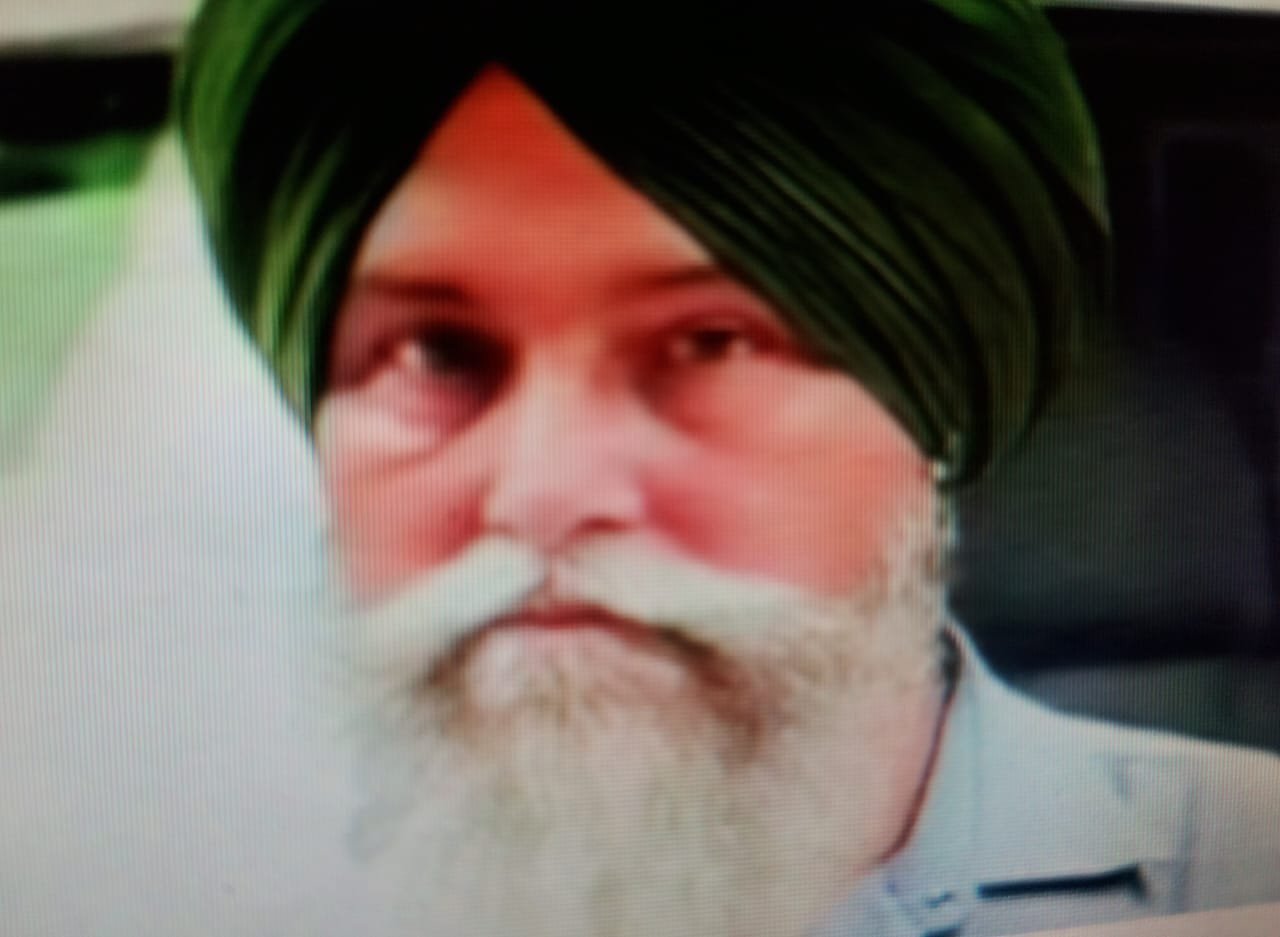
Contents
Lucknow | July 11, 2025
In what could be one of the biggest financial frauds in India’s history, the curtain has finally started to lift. The Uttar Pradesh Economic Offences Wing (EOW) has arrested Gurnam Singh (69) — the key director behind Pearls Agrotech Corporation Ltd (PACL) — from Punjab’s Ropar district.
His crime? Allegedly orchestrating a ₹49,000 crore Ponzi scheme that duped nearly 5 crore investors across India.
This wasn’t just about money. It was about dreams sold and lives broken — mostly belonging to farmers, small shopkeepers, daily wage workers, and middle-class families who trusted PACL with their hard-earned savings.
The Dream That Turned Into a Trap
PACL promised affordable land investments. The plan sounded simple — invest now, and in a few years, you’d either get a valuable land parcel or high returns.
But behind the glittering promises lay a hollow scam.
No land. No returns. Just a web of false paperwork and delayed answers — until one day, even those stopped.
EOW’s New Face — Tough, Accountable, and On a Mission
What’s changed now? The UP EOW has introduced a “Reward and Punish” system to fast-track major financial crime probes like this:
- Monthly performance tracking of officers
- Fast-track teams deployed in every district
- Seizure of properties under Section 111 of the new BNS law
- Helplines, awareness drives, and social media alerts for public support
This new system has already led to 14 arrests, including key names linked to the ₹250 crore V-Care scam and this massive PACL fraud.
This Isn’t Just About Money — It’s About Betrayal
One woman investor said it best:
“We saved for our children’s education, for their future. Now we run around courts and collector offices, with nothing to show for it.”
Behind every number in this scam — there’s a family. A broken promise. A shattered future.
The Bigger Picture
This arrest proves one thing: Justice may be slow, but it’s not blind. ₹49,000 crore didn’t just disappear — it was siphoned off through trust and illusion. The real question now is:
Will India’s legal system bring back justice and money for 5 crore defrauded citizens? Or will this case too fade into the dust of files and forgotten hearings?
India
India Crosses 1.46 Billion — But Why Are People Having Fewer Children? UN Report Reveals the Changing Math of Population

Contents
New Delhi | July11, 2025
There was a time when India’s growing population was considered the country’s biggest problem. Slogans like “Hum Do, Hamare Do” (We Two, Our Two) echoed across walls and radio channels. But times have changed — and so has the narrative.
According to the latest report by the United Nations, India’s population has officially crossed 1.46 billion, making it the most populous nation on the planet. But what’s surprising is this: India’s fertility rate — the number of children a woman has — is steadily declining.
Today, the average Indian woman is giving birth to just two children, which is right around the replacement level needed to maintain a stable population.
So, if fewer children are being born, why is the population still rising? What’s really happening behind these numbers?
This Isn’t Just About Statistics — It’s a Social Shift
There was a time when India was labelled a “population bomb.” Now, several Indian states — including Kerala, Delhi, Tamil Nadu, Karnataka, and Punjab — have fertility rates below replacement level.
This isn’t happening due to force or law — but through education, awareness, and personal choice. It’s a quiet revolution led by society itself.
India is now slowly moving towards population stability, something once thought to be decades away.
Women Are Leading This Change
Behind these shifting numbers is a bigger story — the story of India’s changing women:
- They’re more educated
- They’re joining the workforce
- They’re marrying later
- And they’re making thoughtful, conscious decisions about motherhood
Children are no longer just a tradition — they’re a planned responsibility.
India’s Population Will Peak by 2060 — Then Begin to Decline
Experts say this population growth is the result of demographic momentum — a situation where the current large number of young people continues to reproduce, even as fertility falls.
But once this momentum slows, India’s population will gradually start to decline — marking the beginning of a new era.
That means: the country that is the youngest today may one day become one of the oldest nations in terms of age demographics.
The Real Question Now: What Will We Do With So Many People?
- Can we create enough jobs for all?
- Will our education and healthcare systems be able to handle the pressure?
- And when the population begins to shrink, who will take care of the elderly?
India now needs smart policies, not just to control numbers — but to improve the quality of its population. Because in the long run, it’s not just about how many people we have, but what those people can do.
The Population Game Has Changed
This UN report isn’t just another document filled with stats — it’s a signal that India is entering a new demographic era.
The country is slowly shifting its focus from “how many” to “how capable” — and that’s where real progress begins.
Crime
Shocking Crime in Gurugram: Rising Tennis Star Radhika Yadav Shot Dead — Father Pulls the Trigger Over Career Dispute

Contents
Gurugram | July 11, 2025
In a deeply disturbing incident that has sent shockwaves across Gurugram, 21-year-old national tennis player Radhika Yadav was shot dead in her own home on Sunday morning. The most heartbreaking detail? The shooter was none other than her own father.
Radhika, who had made a mark at the national level in the past two years and had recently been selected for an international tournament, was the pride of her neighborhood. But her promising journey was cut short not by a stranger, but by someone who was supposed to protect her — her father, Ravindra Yadav.
What led to the tragic shooting?
According to initial police reports, Ravindra Yadav confessed during interrogation that he shot Radhika “in a fit of rage.” Investigators reveal that Radhika was passionate about her tennis career and was preparing to travel abroad for further training and competitions — a plan that reportedly didn’t sit well with her father.
Sources close to the family say Ravindra had always been a strict and conservative man. He was uncomfortable with Radhika’s growing independence and career choices. Tensions had been simmering within the household for months. On Saturday night, a heated argument broke out, and by morning, the unthinkable had happened.
Community in shock
The neighborhood is still reeling from the tragedy. Neighbors describe Radhika as a humble, focused, and highly disciplined young woman.
“She would be out for practice every morning by 5 AM. That kind of dedication is rare these days,” said one neighbor, struggling to hold back tears.
Father arrested on the spot
Police arrested Ravindra Yadav at the scene. He has been charged with murder under relevant sections of the IPC. Radhika’s mother, who was reportedly present in the house during the incident, is in deep shock and under medical observation.
A nation reflects: Are dreams still a crime for daughters?
Radhika’s brutal murder has sparked widespread outrage and grief. It has reignited an uncomfortable question — are daughters still being punished for dreaming big?
When a father turns into the very obstacle his daughter must overcome, it’s a mirror held up to our society.
Latest News
Swiss Accounts, Conversion Racket, and Trapped Innocents — This Wasn’t a Saint, He Was a Predator
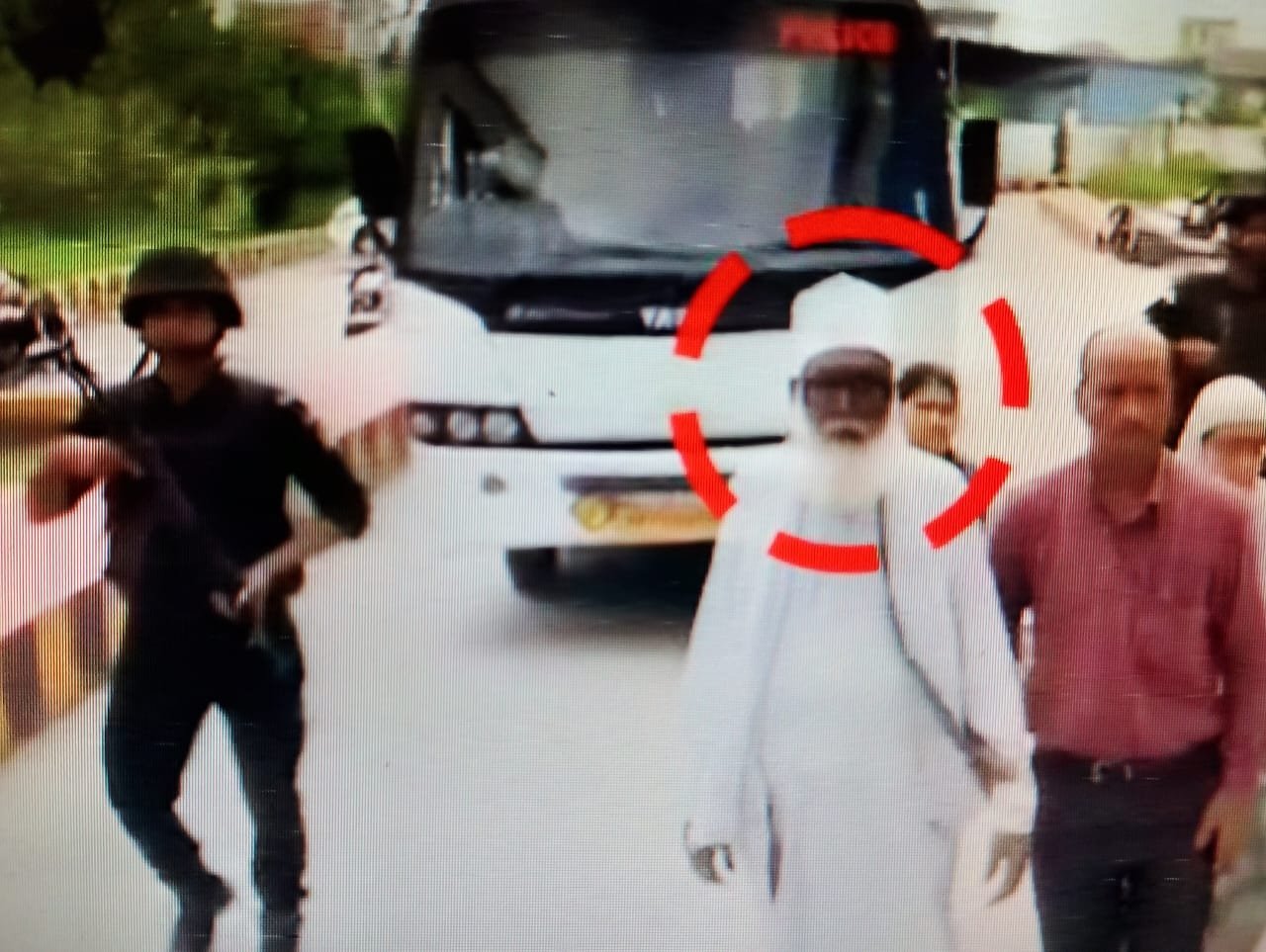
Contents
Uttar Pradesh | 11 July 2025
By Credent TV News Desk
He walked with a staff, wore a long beard, and people in the village folded their hands in reverence at his feet. But behind that saintly image was a man running one of the darkest religious conversion syndicates India has ever seen. His name: Changur Baba. Real name: Jalaluddin. Age: 70. And his list of crimes? Long enough to outlive his age.
A Full-Fledged Conversion Industry
Recent investigations by Uttar Pradesh STF and ATS have uncovered a deeply disturbing reality. This so-called baba wasn’t just chanting prayers — he was masterminding an elaborate system of trapping women and girls into forced religious conversions.
His targets? Minor girls, widows, and poor women — the most vulnerable in society.
His method? Manipulation, emotional blackmail, fake promises of marriage, and when that didn’t work — threats and money.
What’s even more shocking — Baba had a conversion training manual. A complete system of how to trap girls from different religions: what to say, when to act affectionate, and when to threaten.
Fixed rates were decided for each conversion. This wasn’t faith — it was business.
Crores in Swiss Bank Accounts
If you thought this racket was operating on a small scale, think again. Investigators discovered over 40 bank accounts linked to Changur Baba, including several in Switzerland. The total transactions? A staggering ₹106 crore (over $12 million).
Where did the money come from? Sharjah, Dubai, and other Islamic countries, according to the STF.
This was not just a religious racket — it was internationally funded and systematically operated.
Arrested — But the Net Is Wider
On 5th July, STF arrested Changur Baba along with his close aide, Neetu alias Nasreen, from a hotel in Lucknow. During interrogation, it was revealed that the network stretched far — from Mumbai to Dubai.
Now, the Enforcement Directorate (ED) has joined the investigation. A money laundering probe is underway, and authorities are preparing to seize assets and properties linked to the illegal trust and conversions.
A Saint No More
Changur Baba may be behind bars now, but the emotional scars he left on thousands of innocent women can’t be counted in case files or spreadsheets.
He exploited faith to deceive, used trust to destroy, and wore religion as a mask for crime.
As one STF officer said:
“He wasn’t a saint in White. He was a predator in disguise.”
The villagers who once bowed before him now raise questions. How did this go on for so long? And how many more like him are out there?
There’s an old saying:
“When fake saints rise, truth becomes the biggest casualty.”
But this time, the law has spoken. And Baba’s mask has finally fallen.
Bihar
Lalu Yadav Faces Major Setback: HC Accepts CBI’s Plea to Increase Sentence in Fodder Scam Case
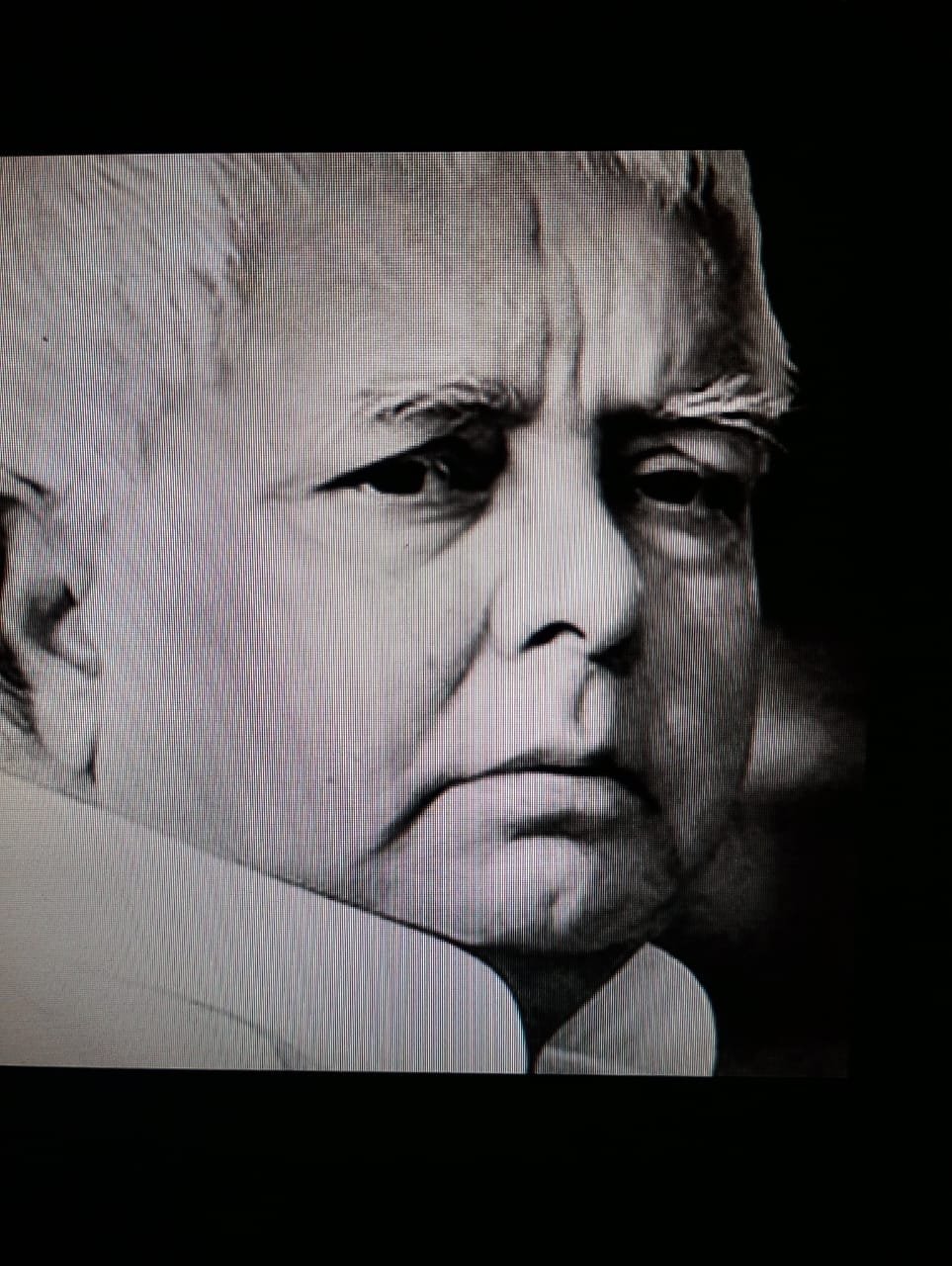
Contents
By Credent TV News Desk
Patna | July 9, 2025
In a major blow to RJD chief and former Bihar Chief Minister Lalu Prasad Yadav, the High Court has accepted the Central Bureau of Investigation’s (CBI) plea to enhance his sentence in the infamous fodder scam case. This ruling could extend Lalu’s prison term significantly.
What’s the case all about?
The fodder scam, which shook the country in the 1990s, involved large-scale embezzlement of government funds in the name of procuring fodder for livestock in Bihar. Crores of rupees were siphoned off using fake bills and fictitious expenses. Lalu Yadav has already been convicted in multiple related cases and has served time in jail. However, this latest development revolves around increasing the length of his sentence.
What did the CBI argue?
The CBI had approached the High Court stating that the lower court had awarded Lalu a lenient sentence considering the seriousness of the crime. According to the agency, a harsher punishment would be more appropriate given the scale of corruption and betrayal of public trust. Agreeing with this argument, the High Court has now permitted an increase in Lalu Yadav’s sentence.
How did Lalu Yadav and his party react?
The RJD camp has gone into damage control mode. Senior leaders have called this move a “political conspiracy” and declared their intent to challenge the verdict in the Supreme Court. While Lalu Yadav himself has not issued a public statement, sources close to him reveal that he is deeply disappointed and disturbed by the judgment.
What’s next?
This ruling could reshape the political landscape for RJD. The spotlight is now on Tejashwi Yadav—will he now fully take over the party’s reins? Meanwhile, rival parties like BJP and JD(U) have hailed the verdict as a strong stance against corruption and a win for accountability.
Expert Take:
The High Court’s decision is being seen as a symbolic moment in the fight against high-level corruption. For a veteran leader like Lalu Yadav to face an extended sentence sends a powerful message: no matter how old the case, justice does not forget.
India
Indian Air Force Jaguar Fighter Jet Crashes in Rajasthan’s Churu: Pilot and Co-Pilot Killed, Wreckage Scattered Across Village

A heart-wrenching tragedy unfolded on Tuesday morning in Rajasthan’s Churu district, where an Indian Air Force Jaguar fighter jet crashed during a routine sortie, claiming the lives of both the pilot and co-pilot. The crash was so severe that the aircraft broke into pieces, scattering debris over a large area and leaving behind the mutilated remains of the officers across different parts of the village.
The incident took place in a quiet rural area of Churu, where the calm of the morning was shattered by a loud explosion. Villagers rushed out of their homes to find smoke billowing from the wreckage scattered across their fields and streets. The blast was followed by chaos as flames engulfed parts of the crash site, and panic gripped the locals.
According to eyewitnesses, the jet appeared to be flying unusually low and suddenly caught fire mid-air. Moments later, it crashed into the ground and exploded with a thunderous blast, sending plumes of smoke and a pungent smell of burning metal into the air. The debris rained down on homes, roads, and farmlands, turning the entire area into a scene of devastation.
Upon receiving the alert, teams from the Indian Air Force and local police rushed to the spot and began rescue and recovery operations. The crash site has since been sealed off, and efforts are underway to collect and examine the wreckage.
Preliminary reports suggest that the Jaguar was on a routine training mission when it encountered a technical malfunction that led to the crash. The Indian Air Force has launched an official investigation to determine the exact cause.
This incident is not just a tragic loss for the Indian Air Force but a moment of deep sorrow for the entire nation. Tributes have been pouring in for the brave officers who lost their lives in the line of duty. Meanwhile, the village where the crash occurred remains gripped by fear and shock.
Credent TV pays heartfelt homage to the fallen heroes of the sky.

 Education1 month ago
Education1 month agoKota ICICI Bank Staffer Swindles ₹4.5 Crore, Gambles It All on Stock Market

 Education2 weeks ago
Education2 weeks ago11 Powerful Reasons Why DAV International Yoga Day Jaipur Uplifted Spirits!

 Bollywood1 month ago
Bollywood1 month agoHousefull 5 Movie Review: Akshay Kumar, Riteish Deshmukh Bring Laughter and Twists in Bollywood’s Biggest Comedy Franchise

 Cricket1 month ago
Cricket1 month agoBengaluru Chinnaswamy Stadium Stampede: 11 Dead, 33 Injured in RCB Victory Parade Chaos

 Education2 weeks ago
Education2 weeks ago7 Inspiring Highlights of DAV Foundation Day Jaipur Celebration – Amazing Vedic Legacy Revealed!

 Education2 weeks ago
Education2 weeks agoEmpowering Educators: A Three-Day Learning Journey at DAV Centenary Public School, Jaipur

 Credent TV2 weeks ago
Credent TV2 weeks agoVIBGYOR Summer Camp Ends on a High at DAV Centenary Public School, Jaipur

 Election4 days ago
Election4 days agoDAV Centenary Public School, Vaishali Nagar, Jaipur Event Report: Talent Hunt Show




































